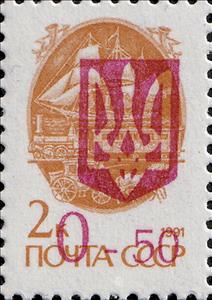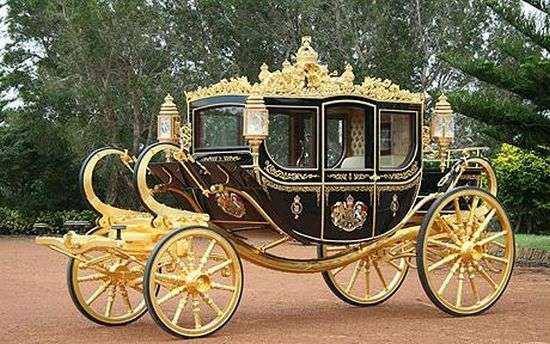Stamp: 0.50 K Surcharge On 2k Bistre-orange (solid) (Ukraine 1992)
0.50 K Surcharge On 2k Bistre-orange (solid) (Ukraine 1992)
04 March (Ukraine ) within release 0.50 K Surcharge On 2k Bistre-orange (solid) goes into circulation Stamp 0.50 K Surcharge On 2k Bistre-orange (solid) face value 50 Ukrainian karbovanets
| Stamp 0.50 K Surcharge On 2k Bistre-orange (solid) in catalogues | |
|---|---|
| Colnect codes: | Col: UA 1992.03.04/1 |
Stamp is vertical format.
Bylen/Kuzych no. UA BK11. BK11, a solid trident (type II), occupies the position of second stamp from the left on the second row as printed on the original sheet.Stamp 0.50 K Surcharge On 2k Bistre-orange (solid) it reflects the thematic directions:
A carriage is a two- or four-wheeled horse-drawn vehicle for passengers. Second-hand private carriages were common public transport, the equivalent of modern cars used as taxis. Carriage suspensions are by leather strapping or, on those made in recent centuries, steel springs. Two-wheeled carriages are usually owner-driven.
The horse (Equus ferus caballus) is one of two extant subspecies of Equus ferus. It is an odd-toed ungulate mammal belonging to the taxonomic family Equidae. The horse has evolved over the past 45 to 55 million years from a small multi-toed creature, Eohippus, into the large, single-toed animal of today. Humans began to domesticate horses around 4000 BC, and their domestication is believed to have been widespread by 3000 BC. Horses in the subspecies caballus are domesticated, although some domesticated populations live in the wild as feral horses. These feral populations are not true wild horses, as this term is used to describe horses that have never been domesticated, such as the endangered Przewalski's horse, a separate subspecies, and the only remaining true wild horse. There is an extensive, specialized vocabulary used to describe equine-related concepts, covering everything from anatomy to life stages, size, colors, markings, breeds, locomotion, and behavior.
A modern sailing ship or sailship is any large wind-powered vessel. Traditionally a sailing ship (or simply ship) is a sailing vessel that carries three or more masts with square sails on each. Large sailing vessels that are not ship-rigged may be more precisely referred to by their sail rig, such as schooner, barque (also spelled "bark"), brig, barkentine, brigantine or sloop. There are many different types of sailing ships, but they all have certain basic things in common. Every sailing ship has a hull, rigging and at least one mast to hold up the sails that use the wind to power the ship. The crew who sail a ship are called sailors or hands. They take turns to take the watch, the active managers of the ship and her performance for a period. Watches are traditionally four hours long. Some sailing ships use traditional ship's bells to tell the time and regulate the watch system, with the bell being rung once for every half hour into the watch and rung eight times at watch end (a four-hour watch). Ocean journeys by sailing ship can take many months, and a common hazard is becoming becalmed because of lack of wind, or being blown off course by severe storms or winds that do not allow progress in the desired direction. A severe storm could lead to shipwreck, and the loss of all hands. Sailing ships are limited in their maximum size compared to ships with heat engines, so economies of scale are also limited. The heaviest sailing ships (limited to those vessels for which sails were the primary means of propulsion) never exceeded 14,000 tons displacement. Sailing ships are therefore also very limited in the supply capacity of their holds, so they have to plan long voyages carefully to include many stops to take on provisions and, in the days before watermakers, fresh water.
A trident (/ˈtraɪdənt/) is a three-pronged spear. It is used for spear fishing and historically as a polearm. As compared to an ordinary spear, the three tines increase the chance that a fish will be struck and decrease the chance that a fish will be able to dislodge itself if struck badly. On the other hand, they are not so many as to overly reduce the spear's concentration of force for piercing. '




